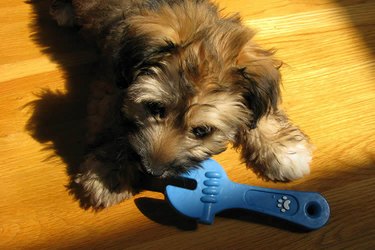It's not uncommon for dogs to protect their toys by growling or snarling when someone tries to take them away. However, if this behavior is left unchecked, it can lead to snapping or full biting. Understanding why dogs get territorial with their toys or other objects, areas, or people will help you decide how you want to train this behavior out of them.

Video of the Day
Dog or puppy growling when playing with toys
Dogs growling when someone tries to take away their food, water, bowl, or other possession is natural. It's sometimes referred to as "resource guarding" or "canine possession aggression." It's natural for dogs to be possessive, especially in a house with other pets. However, you can and should stop this behavior as soon as possible. The longer you let it go on, the more serious it can become, and it's hard to deal with when a dog is older.
Video of the Day
Should you try training him yourself?
A puppy growling when playing with toys is not unusual. You can probably begin training him yourself. Always use positive reinforcement and not punishment. You want your dog to want to do the right thing, not behave in a certain way to avoid punishment. If you are dealing with an adult dog, especially one you have not raised from a pup, you might need to call in a professional dog trainer.
If the dog bares his teeth and lunges, the behavior might be too ingrained for you to try to change it yourself. Talk to your vet or a professional trainer and show him the behavior (record it on your phone). He will tell you how serious the problem is and whether you can try to train the dog yourself. Possession aggression can extend to a favorite piece of furniture, an area of the house, or even another pet or human.
Do it in degrees
As you begin to train the dog, don't let the dog have possession of the toy first and then try to take it away. You should be the one to introduce the toy, playing with it and then handing it to the dog. You can then hold out your hand and ask the dog to give it back/share with you.
You can also confine the dog in his cage or behind a fence or gate and put the toy out of the dog's reach. You can then pick up the toy and play with it a bit and then give it to the dog. The dog will learn that you are not going to take away the toy and keep it for yourself.
Use treats as rewards
Giving treats as rewards for specific behavior is a great way to train almost any dog. Give the dog a toy that you have handled and played with. After the dog has played with the toy a bit, hold out a treat and choose a command like "drop," or "leave." You might also try "bring" and have the dog give you the toy in exchange for the treat. If he drops the toy and comes for the treat, point to the toy and say "bring!" Work on this until he brings you the toy.
Once the dog drops the toy or offers it to you (whichever behavior you're training), tell the dog "good boy!" and give him the treat. Repeat this pattern with different toys so the dog associates giving up the toy with being rewarded. You can give the toy back to the dog after he finishes the treat or keep it and give him another toy.
Practice with food too
A dog who is protective of toys is probably also protective of her food, water, and bowls. Teach her that you are not a threat to take her food. Let her know that you are the provider of her food and the owner of the food.
Don't put out food and water when the dog is in another room and then call the dog in. Let the dog see you putting the food and water in the bowls. Stand over the bowls once they are filled to let the dog know that you are in charge.
Next, call the dog over and let her start eating and drinking. Pet her and talk to her while she's eating and drinking. If you are serving dry dog food, take it out of the bag in your hands and put it in the bowl rather than pouring it out of the bag or using a scoop. Then, call to the dog to come and eat "your" food that you've put out/provided for her.